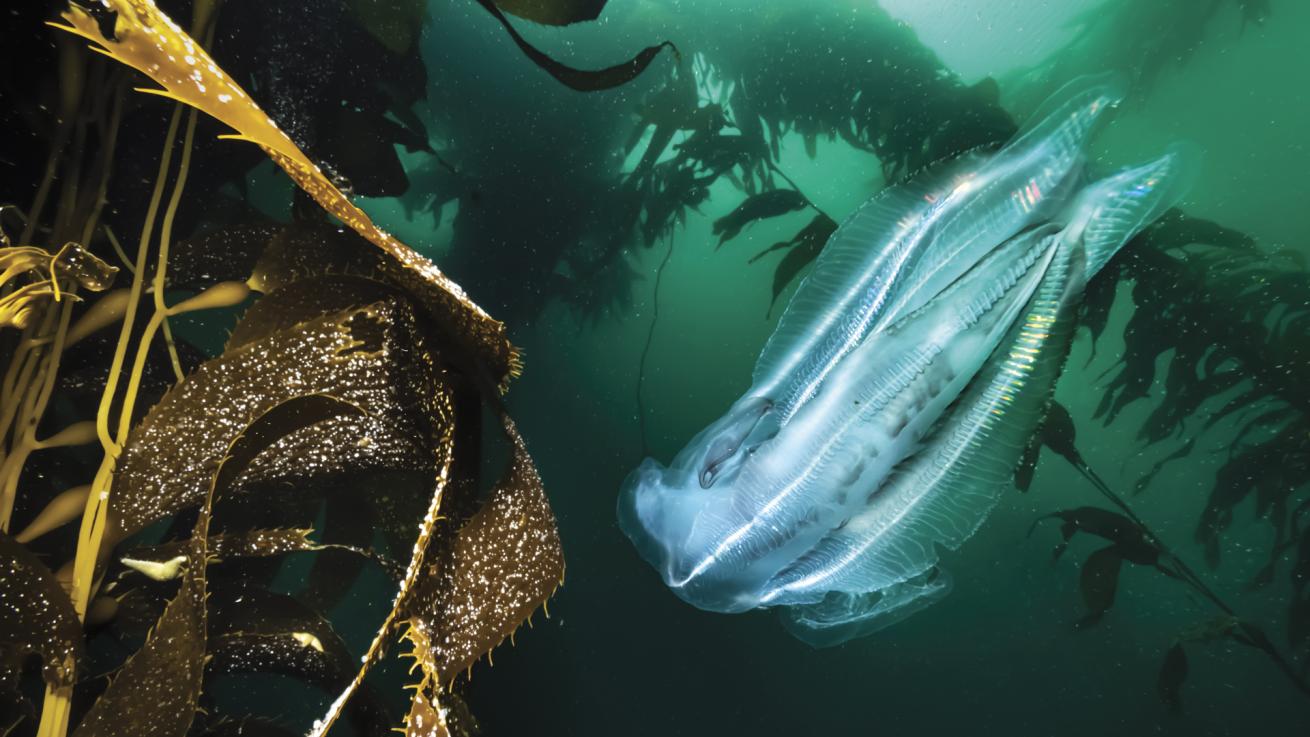Discovering Patagonia's Winged Comb Jelly

Patrick WebsterA winged comb jelly (Pterygiocteis pinnatus) soars past Patagonian giant kelp off Tierra del Fuego, South America.
Dive Log
1155 hours, March 11, 2023
Argentine Patagonia, approx.
54°44'S 63°51'W
Water temperature: 41ºF / 5ºC
Ever since we boarded Lindblad's National Geographic Resolution and sailed into this idyllic Patagonian fjord, I’ve had eyes only for this spot. It’s one of those “How is this actually my job?” moments. While the guests explore on shore, I’ll record what’s underwater to share later over cocktail hour. Years of exploring the chillier side of things in the Northeast Pacific have found me staring at a similar glacially carved fjord environment— Staten Island’s impenetrable beech trees the southern interpretation of Alaska’s spruce and hemlock.
It’s as wild a place as I’ve ever been but the ocean feels inviting: There, lining the steep cliffs is that familiar ring of giant kelp canopy carpeting my backyard half the world away.
If you flipped the world upside down, these same latitudes and cold-water ecosystems would be the ones that first welcomed me into the ocean. And while I grew up in church, my first religious experiences came in what I’ve come to call the Kelp Kathedrals of Monterey Bay. Now, even here near the edge of the world are more algal amphitheaters to worship within.
Related Reading: Coldwater Dispatches: Polar Jellyfish
The kelp is calling, and I must go! Splash
Wow. This must be what Alice felt when she stepped through the looking glass, a disorienting familiarity. This forest seems just like my home woods—except when you take a closer look, nothing is quite the same. The kelp is a different color—lighter green, even ghostly at times. It’s eerie and comforting all at once.
“Look at all these stalked jellyfishes on the kelp next to these... mussels, I guess? And what’s up with these kelp-climbing sea stars? And where did all the fish go? And what’s that weird balding sea urchin? And—whoa! Drifters!”
If there’s anything to snap you out of an alien underwater experience, it’s coming face to face with one. On the edge of the forest the sea is fizzing with copepods, siphonophores, salp chains and comb jellies.
One in particular stands out about 20 centimeters, 8 inches or so, purple banding along its comb rows, and those... spoilers? Foils? Like coattails off its rear end, opposite the frontal lobes. It reminds me of Leucothea pulchra, the “beautiful sea goddess” comb jelly of the Northeast Pacific, a midwater Roomba that prowls for plankton.
Comb jellies are in a biological league of their own, their phylum of Ctenophora being considered by some as even more ancestral to life than the sponges. This jelly isn’t in any of the ID books—best thing to do now is to upload an observation to iNaturalist.org, tag a few jelly experts and wait!
[A few weeks later]
Related Reading: Diving for Critters in North America's Fjords
Oh! Dr. Claudia Mills responded on iNaturalist. No way! She says: “These images will help describe a brand-new species of comb jelly.” The lovely lobate has rarely been seen, mostly around Ushuaia, Argentina. This newest leaf on the tree of life is Pterygiocteis pinnatus, the pinnate winged comb jelly.
It’s difficult to describe the feeling of ever-imminent discovery that diving brings, and maybe that’s why we divers develop such a kinship, an unspoken understanding that we have all explored at the limits of human knowledge, just by gearing up and going for a dive. And it is truly remarkable where diving can take us in this water world, when training and circumstances align, finding yourself through the looking glass in a familiarly alien cold-water forest on the other side of the planet, the jagged skyline of the Patagonian fjords reminding you just how much more the ocean still has to offer.
As a diving naturalist aboard the Lindblad Expeditions National Geographic fleet of expedition vessels, Pat Webster often finds himself plunging into the frigid waters of remote, rarely explored places. Dive into his expedition journals at sea to get a glimpse of these far-flung locales from a diver’s perspective.










